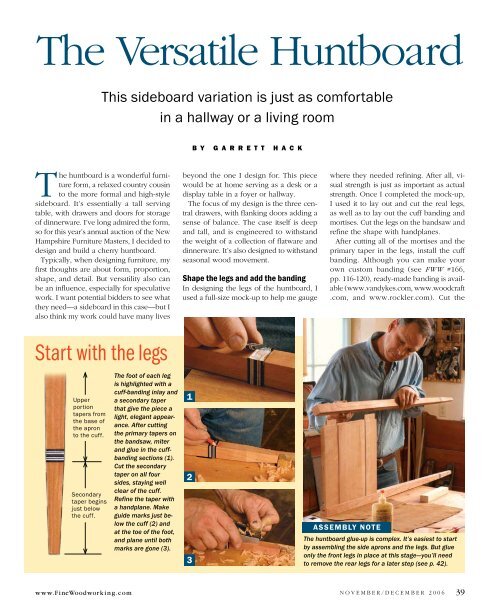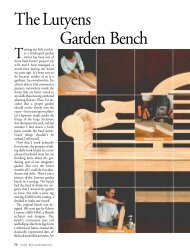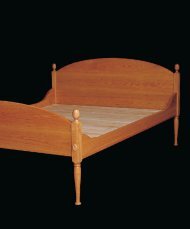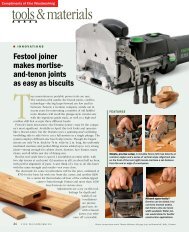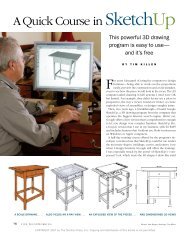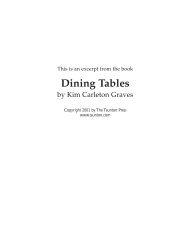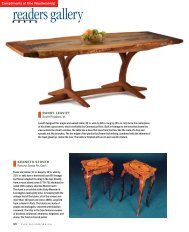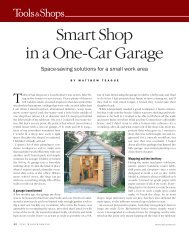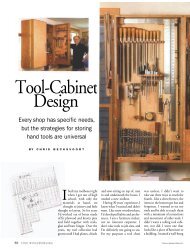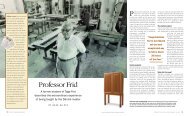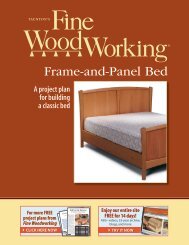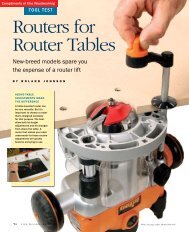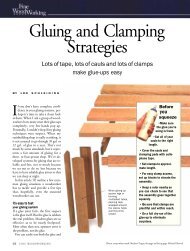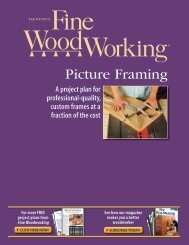Download PDF - Fine Woodworking
Download PDF - Fine Woodworking
Download PDF - Fine Woodworking
Create successful ePaper yourself
Turn your PDF publications into a flip-book with our unique Google optimized e-Paper software.
The Versatile Huntboard<br />
This sideboard variation is just as comfortable<br />
in a hallway or a living room<br />
The huntboard is a wonderful furniture<br />
form, a relaxed country cousin<br />
to the more formal and high-style<br />
sideboard. It’s essentially a tall serving<br />
table, with drawers and doors for storage<br />
of dinnerware. I’ve long admired the form,<br />
so for this year’s annual auction of the New<br />
Hampshire Furniture Masters, I decided to<br />
design and build a cherry huntboard.<br />
Typically, when designing furniture, my<br />
first thoughts are about form, proportion,<br />
shape, and detail. But versatility also can<br />
be an influence, especially for speculative<br />
work. I want potential bidders to see what<br />
they need—a sideboard in this case—but I<br />
also think my work could have many lives<br />
Start with the legs<br />
Upper<br />
portion<br />
tapers from<br />
the base of<br />
the apron<br />
to the cuff.<br />
Secondary<br />
taper begins<br />
just below<br />
the cuff.<br />
The foot of each leg<br />
is highlighted with a<br />
cuff-banding inlay and<br />
a secondary taper<br />
that give the piece a<br />
light, elegant appearance.<br />
After cutting<br />
the primary tapers on<br />
the bandsaw, miter<br />
and glue in the cuffbanding<br />
sections (1).<br />
Cut the secondary<br />
taper on all four<br />
sides, staying well<br />
clear of the cuff.<br />
Refine the taper with<br />
a handplane. Make<br />
guide marks just below<br />
the cuff (2) and<br />
at the toe of the foot,<br />
and plane until both<br />
marks are gone (3).<br />
B y G a r r e t t H a c k<br />
beyond the one I design for. This piece<br />
would be at home serving as a desk or a<br />
display table in a foyer or hallway.<br />
The focus of my design is the three central<br />
drawers, with flanking doors adding a<br />
sense of balance. The case itself is deep<br />
and tall, and is engineered to withstand<br />
the weight of a collection of flatware and<br />
dinnerware. It’s also designed to withstand<br />
seasonal wood movement.<br />
Shape the legs and add the banding<br />
In designing the legs of the huntboard, I<br />
used a full-size mock-up to help me gauge<br />
1<br />
2<br />
3<br />
where they needed refining. After all, visual<br />
strength is just as important as actual<br />
strength. once I completed the mock-up,<br />
I used it to lay out and cut the real legs,<br />
as well as to lay out the cuff banding and<br />
mortises. Cut the legs on the bandsaw and<br />
refine the shape with handplanes.<br />
After cutting all of the mortises and the<br />
primary taper in the legs, install the cuff<br />
banding. Although you can make your<br />
own custom banding (see FWW #166,<br />
pp. 116-120), ready-made banding is available<br />
(www.vandykes.com, www.woodcraft<br />
.com, and www.rockler.com). Cut the<br />
assembly note<br />
The huntboard glue-up is complex. It’s easiest to start<br />
by assembling the side aprons and the legs. But glue<br />
only the front legs in place at this stage—you’ll need<br />
to remove the rear legs for a later step (see p. 42).<br />
www.<strong>Fine</strong>Woodwor k i n g.com N o V E M B E r / d E C E M B E r 2 0 0 6 39


